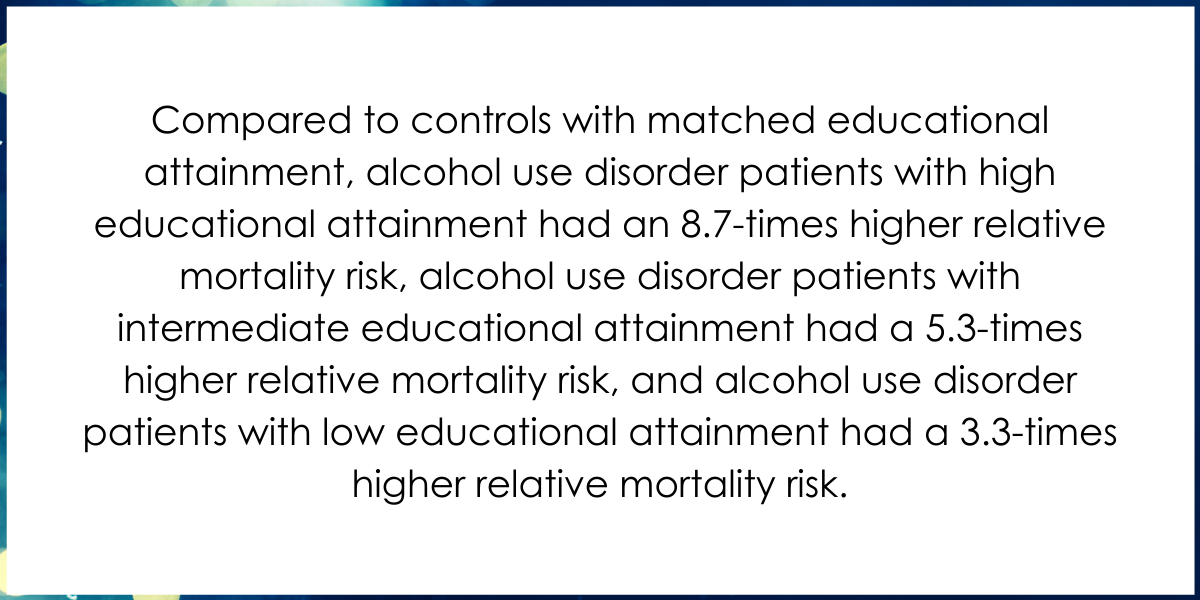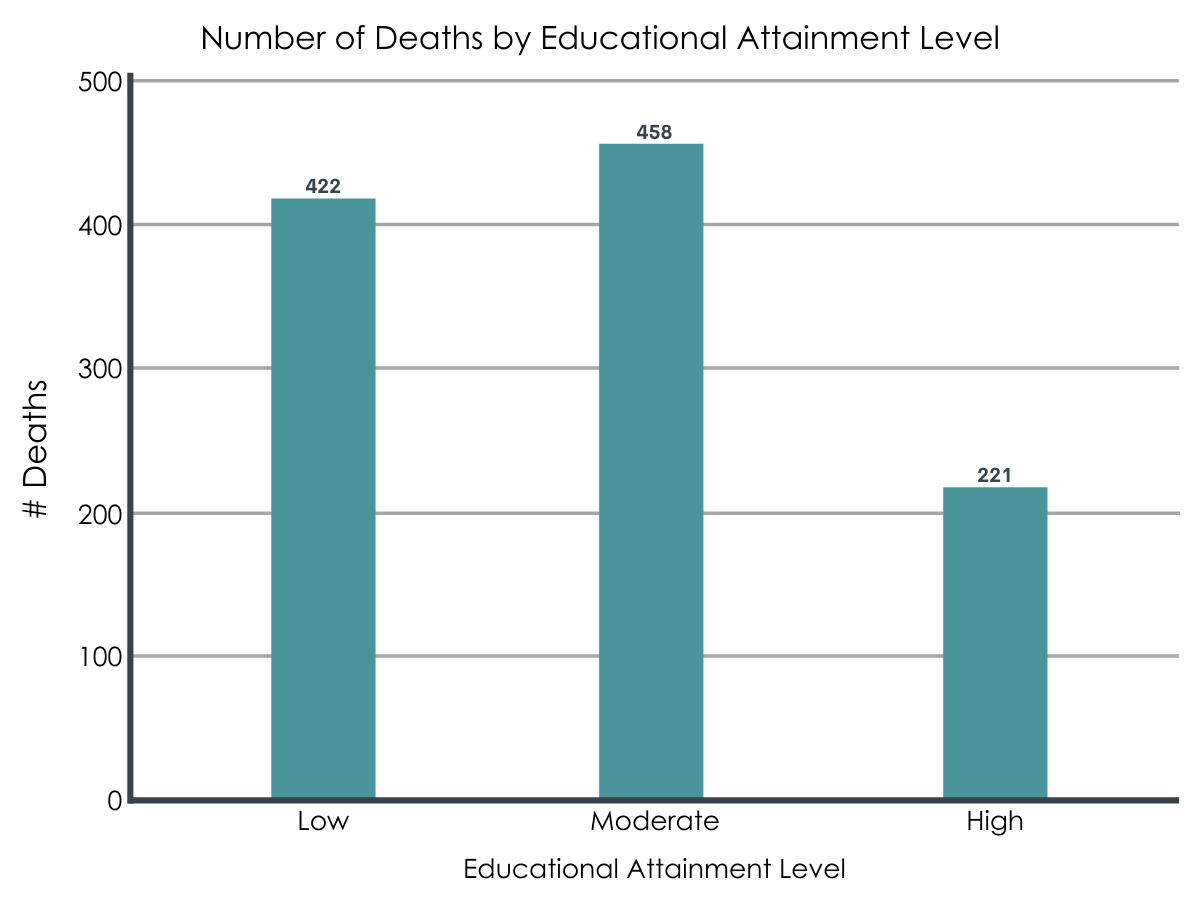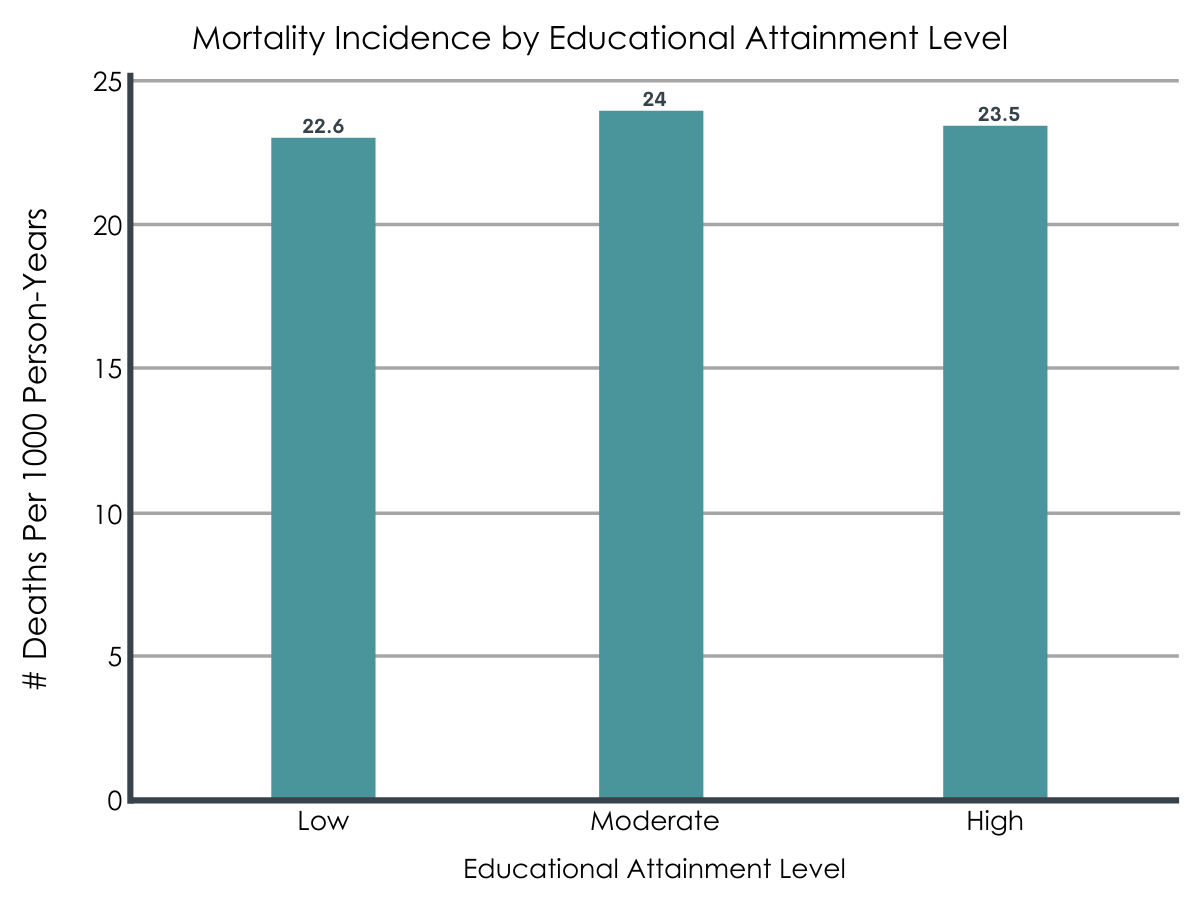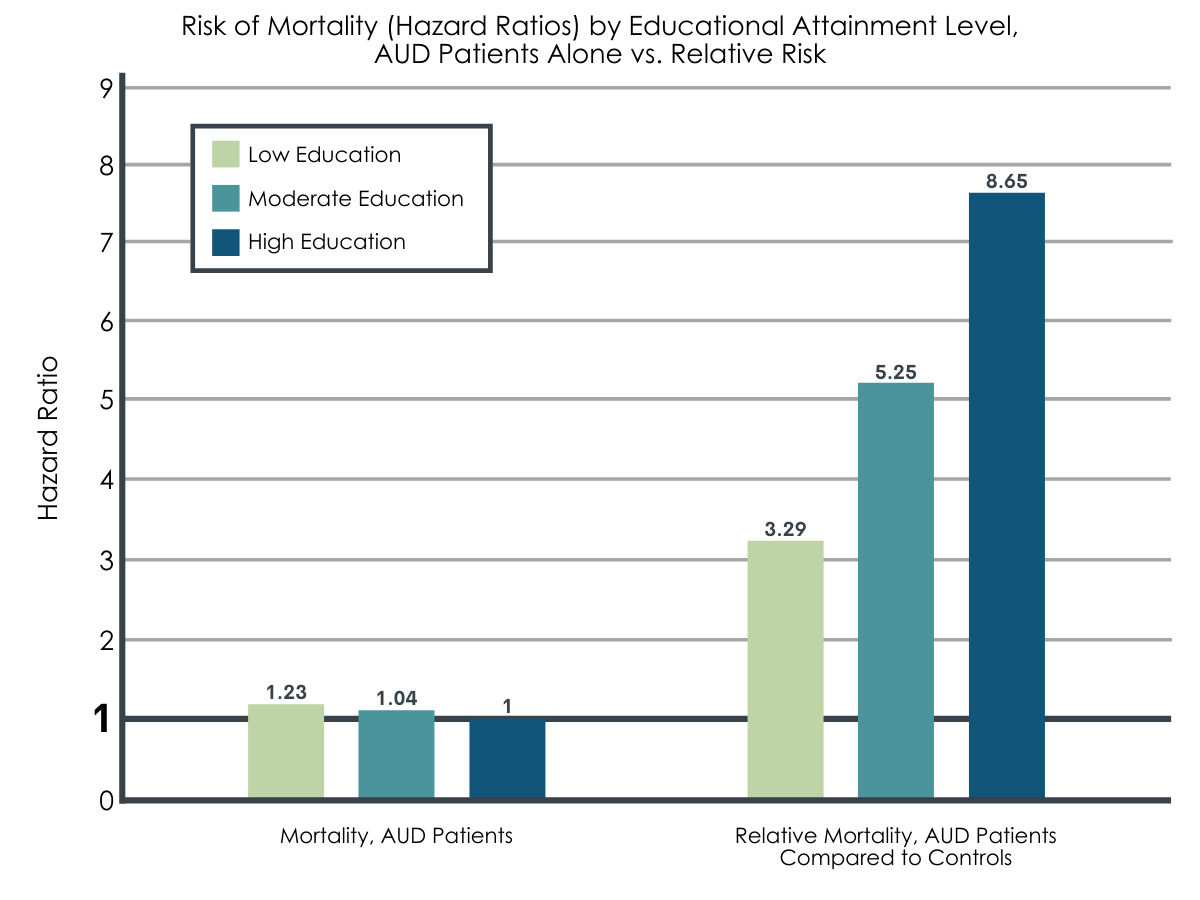Alcohol use disorder has the strongest link to mortality for those with the highest levels of education
Compared to individuals with higher socioeconomic status, individuals with low socioeconomic status have increased mortality risk both generally for all causes and specifically for alcohol-related causes. To understand the specific effects of alcohol use disorder on mortality, it is important to account for these general elevated mortality rates among people in lower socioeconomic status groups. In this prospective cohort study of adults with alcohol use disorder, researchers investigated whether there are differences in alcohol use disorder outcomes for different socioeconomic status groups and also estimated the relative risks of adverse events when compared to the general population.
WHAT PROBLEM DOES THIS STUDY ADDRESS?
Worldwide mortality rates from alcohol are ten times that of all illicit drugs combined. Alcohol related risk of premature death is dose dependent, with risk rising as overall consumption of alcohol increases. Interestingly, the exposure-outcome link changes across socioeconomic status groups. Low socioeconomic status groups experience more alcohol-related consequences, including deaths. These observations suggest that alcohol causes disproportionate harm among low socioeconomic status groups.
The association between socioeconomic status and alcohol use disorder outcomes is not well-understood. A strong marker of socioeconomic status is education. One theory is that having high educational attainment may contribute to an individual’s ability to maintain a heavy drinking career over a long period of time. People with high educational attainment tend to have more robust social support and better health habits, which may allow them to offset the potential downsides of heavy drinking over long periods of time. People with alcohol use disorder who have low educational attainment already face a greater likelihood of premature death due to stress factors related to their lower socioeconomic status. Conversely, mortality risk for people with alcohol use disorder (versus heavy alcohol use that does not rise to the level of a disorder) who have high educational attainment may be more strongly attributed to the specific effect of alcohol-related problems because social support and health habits are less able to offset their overall risk of premature death.
In studies investigating whether socioeconomic group impacts the mortality risk for individuals with alcohol use disorder compared to the general population, researchers have reported mixed findings, including no differences across socioeconomic status groups, lower risk in high socioeconomic status groups compared to medium and low socioeconomic status groups, and higher risk in high socioeconomic status groups compared to medium and low socioeconomic status groups.
In this study, researchers sought to increase our understanding of the intersecting relationships between socioeconomic status, alcohol use disorder, and mortality risk, using a prospective cohort study comparing Norwegian adults with alcohol use disorder who attended specialized substance use disorder treatment or received care at a psychiatric hospital against their counterparts in the general population (control condition).
HOW WAS THIS STUDY CONDUCTED?
The researchers conducted a prospective cohort study using electronic medical record data collected by the Norwegian Patient Registry, which covers all patients in the public, universal healthcare system in Norway. Individuals were included in the study if they were admitted to psychiatric care between January 2009 and December 2010, diagnosed with an alcohol-related disorder as their primary condition, and at least 20 years of age.
Socioeconomic status was defined as highest completed education: low (only mandatory education), intermediate (all education levels between low and high), and high (completed college or university education). Given that the research team operationalized socioeconomic status (a combination of education, income, and employment) as highest level of education only, socioeconomic status here refers simply to level of education.
Obtained from Norway’s Cause of Death Registry, mortality was defined as number of deaths per 1,000 person-years. Person-years under observation were calculated from the date of study entry (defined by date of treatment admission for alcohol use disorder patients, or January 1, 2010, for the control participants from the general population) through date of study exit (defined by date of death or emigration, or December 31, 2013). All education, emigration, and death data were linked using national ID numbers.
Primary outcomes included treatment admission, all-cause mortality, and relative mortality (mortality risk for patients with alcohol use disorder, compared to their counterparts in the general population). Treatment admission was calculated using a logistic regression model, where high educational attainment was the reference category and age, gender, and their interaction were controlled. Absolute and relative mortality risk were calculated from the number of deaths per 1,000 person-years. Absolute mortality risk was calculated using a hazard ratio, which compared the number of deaths in the low and intermediate educational attainment groups against the number of deaths in the high educational attainment group. Absolute mortality risk was compared across the three education levels: low (only mandatory education), intermediate (all education levels between low and high), and high (completed college or university education). Relative mortality risk was based on comparisons between patients with alcohol use disorder and their control group counterparts in the general population for each education level.
The study included N=23,781 participants followed over a period of nearly 4 years. The total number of person-years observed – that is, the total number of years of observation included in study analyses across all participants – was 94,681. Both the alcohol use disorder patient and control cohorts included 30% women (N=3,474, N=3,568). For alcohol use disorder patients, the sample included 40% of participants in the low educational attainment group, 40% in the intermediate educational attainment group, and 20% in the high educational attainment group. For control participants from the general population, the sample included 22% of participants in the low educational attainment group, 43% in the intermediate educational attainment group, and 35% in the high educational attainment group.
WHAT DID THIS STUDY FIND?
Among those with alcohol use disorder, individuals in the low education level group had the overall greatest risk for inpatient treatment and death.
Compared to people with high educational attainment, people with intermediate educational attainment were 1.7-times more likely to enter alcohol use disorder treatment, while people with low educational attainment were 3.3-times more likely to enter alcohol use disorder treatment.
Compared to alcohol use disorder patients with higher educational attainment, alcohol use disorder patients with low educational attainment had a 1.2-times higher absolute risk of dying, while alcohol use disorder patients with intermediate educational attainment did not have a higher absolute risk of dying. Among alcohol use disorder patients over 60 years of age, those with low educational attainment had a 1.4-times greater absolute risk of dying.
Compared to control participants a substantially increased mortality risk for those with alcohol use disorder was observed and was most pronounced among those with higher levels of education.
Compared to controls, alcohol use disorder patients overall had a 5-times higher mortality incidence.

Figure 1.
Compared to controls with matched educational attainment, alcohol use disorder patients with high educational attainment had an 8.7-times higher relative mortality risk, alcohol use disorder patients with intermediate educational attainment had a 5.3-times higher relative mortality risk, and alcohol use disorder patients with low educational attainment had a 3.3-times higher relative mortality risk.

Figure 2.
Also, compared to alcohol use disorder patients with intermediate educational attainment, alcohol use disorder patients with high educational attainment had higher relative mortality risk, while alcohol use disorder patients with low educational attainment did not.

Figure 3.

Figure 4. The research team used hazard ratios (HRs) to determine chance of mortality among alcohol use disorder (AUD) patients alone, and as compared to controls without AUD. An HR of 1 essentially indicates that there is equal chance of mortality between that group and the control to which they are being compared, while an HR greater than 1 indicates increased chance (e.g., HR of 4 = 4 times greater chance).
WHAT ARE THE IMPLICATIONS OF THE STUDY FINDINGS?
This prospective cohort study investigated differences in alcohol-related outcomes among based on educational attainment levels among Norwegian adults with alcohol use disorder. In this study, the researchers found that low educational attainment among those with alcohol use disorder was associated with greater risk of treatment admission and death. In contrast to education matched controls in the general population, however, those with alcohol use disorder who had the highest educational attainment had the greatest risk of mortality.
The researchers found that people with low educational attainment were more likely to be admitted to psychiatric care for alcohol use disorder, which aligns with previous research (here and here) on the greater risk of alcohol-related morbidity among people with low socioeconomic status.
Corresponding with results from previous studies (here and here), the researchers found that in the general population, people in low socioeconomic status groups may face a higher risk of premature death than people in medium or high socioeconomic status groups due to the frequency of health risks like smoking and high body mass index. This higher level of risk persists for the population of people in low socioeconomic status groups who have alcohol use disorder and is further elevated by their heavy alcohol use.
The researchers found that compared to socioeconomic status groups in the general population, alcohol use disorder patients with high educational attainment had much greater relative mortality risk, after controlling for other factors. These findings align with two previous studies (see here and here) on alcohol-related mortality risk, which both found greater relative mortality risk among people with alcohol use disorder who had high educational attainment.
Notably, the researchers found a higher relative mortality risk among people with alcohol use disorder who have high educational attainment who were over 60 years of age, compared to their age-matched counterparts in the general population, while no difference was observed in the under-60 group. A possible explanation for these results is that for people with alcohol use disorder who have high educational attainment and who are older, alcohol use disorder contributes more significantly to mortality risk because alcohol has toxic effects that are amplified with age. In addition, people with alcohol use disorder who have high educational attainment do not share the same risk factors for premature death that people with low educational attainment face (e.g., smoking and high BMI). As a result, the relative impact of alcohol use disorder on mortality risk is especially pronounced among those who have high educational attainment.
- LIMITATIONS
-
- Because the study only included people with alcohol use disorder who were admitted to specialized psychiatric care, the participants in the sample were probably older and had greater clinical severity than people with alcohol use disorder in the general population, which may have contributed to greater relative mortality risk.
- Although most alcohol use disorder treatment in Norway is delivered in the public healthcare system, a minority of individuals with alcohol use disorder who have high socioeconomic status seek alcohol use disorder treatment at private clinics, which may lead to an inflated negative social gradient.
- Like other observational studies based on electronic healthcare record, this study was limited by its reliance on routine diagnoses in specialized healthcare services, which may contain inaccuracies due to diagnostic misclassification or administrative errors.
- The researchers did not report a measure of AUD severity, which may have affected alcohol-related morbidity and mortality. The researchers defined AUD diagnosis using the ICD-10’s F10 code, which encompasses alcohol use disorder and dependency across multiple severity levels.
BOTTOM LINE
In this prospective study of Norwegian adults admitted to psychiatric care for alcohol use disorder from 2009 to 2010, the researchers found that people with alcohol use disorder who have low educational attainment face a greater risk of treatment admission and greater absolute risk of mortality compared to those with high educational attainment. However, compared to matched controls in the general population, people with alcohol use disorder who have high educational attainment face a much greater relative risk of mortality. In general, people with alcohol use disorder who have low educational attainment are more affected by worse alcohol-related outcomes. In this group, the harmful effects of alcohol use disorder are compounded by the risk of premature death linked to low educational attainment. Because people with alcohol use disorder who have high educational attainment do not share the same risk factors for premature death that people with low educational attainment face (e.g., smoking and high BMI), the relative impact of alcohol use disorder on mortality risk is especially pronounced among those who have high educational attainment. While differences in socioeconomic status and educational attainment influence the course of alcohol-related morbidity and mortality, early engagement with treatment and recovery support services may be critical for preventing premature death across all social groups.
- For individuals and families seeking recovery: In this study, the researchers found a high risk of mortality among all alcohol use disorder patients, with alcohol use disorder patients showing a 5-times greater risk of mortality than the general population. Alcohol use disorder patients with low educational attainment had a non-significantly higher absolute risk of mortality, while alcohol use disorder patients with high educational attainment had a significantly higher relative risk of mortality compared to their counterparts in the general population. Although differences in educational attainment or socioeconomic status can certainly influence the course of alcohol-related morbidity, engaging with treatment and recovery support services early in the course of illness may be critical for preventing premature death.
- For treatment professionals and treatment systems: This study found a high risk of mortality among all alcohol use disorder patients across educational attainment groups, with small differences observed between groups. Given treatment can result in higher rates of alcohol use disorder remission and diminish related harms, these findings suggest that early intervention and engagement with alcohol use disorder treatment may be critical for preventing premature death.
- For scientists: This study presented interesting findings about differences in alcohol-related outcomes across educational attainment groups (which the researchers used as a proxy for socioeconomic status). More research on socioeconomic status group differences, based on other markers like income or occupational status, is necessary to draw further conclusions about socioeconomic status affects alcohol-related outcomes.
- For policy makers: Building upon established literature, this study showed the link between alcohol use disorder and high mortality risk across educational attainment groups (which the researchers used as a proxy for socioeconomic status). Low educational attainment was associated with higher absolute risk of mortality, while high educational attainment was associated with much higher relative risk of mortality compared to their general population counterparts without alcohol use disorder but with similar levels of education. Both findings point to the importance of implementing policies that offer early and convenient access to alcohol use disorder treatment for people with alcohol use disorder across all socioeconomic status groups.
CITATIONS
Rossow, I., Amundsen, E.J., & Samuelsen, S.O. (2020). Socio-economic differences in all-cause mortality in people with alcohol use disorder: A prospective cohort study. Addiction, 116, 53-59. DOI: 10.1111/add.15070

